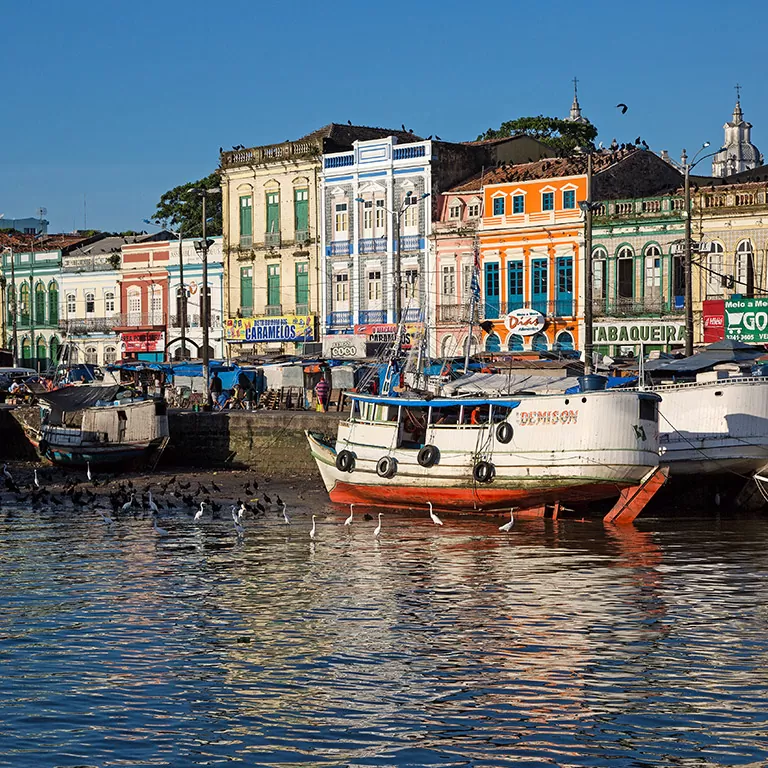
The capital of the state of Para, Belem, developed along the margins of Guaruja Bay, after the arrival of the Portuguese in 1616, which explains why it is cosmopolitan, is a port, and has beautiful architecture, being known at the time as “Paris in America”. Due to its equatorial climate, and influenced by the Amazon Forest, it is the rainiest capital in Brazil. This gives an even more pleasant touch to the traditional façades of the mansions and churches of the colonial period, blended with the modern buildings that emerged due to the plan for enhancing the value of space in the city, with the resulting vertical growth.
A cultural, political and economic model for the region, which includes all of the state of Para, and the states of Amapa and Tocantins, Belem is the second most visited city in Amazonia, due to its various offers of culture and leisure. Besides the world famous Cirio de Nazare (Taper of Our Lady of Nazareth), Belem is the venue for several fairs: the FITA – Feira Internacional de Turismo da Amazonia (International Tourism Fair of Amazonia); the Feira Amazonica do Livro (Amazonian Book Fair); and the Feira Supernorte (Supernorth Fair) – considered the major business event in the North of Brazil – besides fashion events, such as the Belem Fashion Days and the Amazonia Fashion Week.
Cirio de Nazare
The biggest Christian procession on the planet, in honor of Our Lady of Nazareth, the state’s patron saint, it moves the economy and tourism in the capital, receiving over 2 million people. The event is held on the second Sunday in October, on a march of 3.6km, from the Belem Cathedral to the Sanctuary of Nazareth Square.
Gastronomy
Belem’s rich cookery is presented in charming establishments and in public parks. It represents the popular tradition that every inhabitant of Para – and every tourist – should enjoy a good “tacaca” at 3:00 pm, just as the English enjoy their 5:00 o’clock tea. Therefore, you’ll find the dish in the main avenues and streets of the city. This exotic regional dish is served in a gourd, with a broth of “tucupi” with shrimp and manioc starch. Among drinks, you’ll find the “jambu cachaça”, which makes drinkers tremble and feel a slight numbness in their lips. Another typical drink, “bacun” juice, is ideal to accompany the “unha”, a crab delicacy. Not forgetting, of course, “maniçoba”, a soup made with shrimp and several regional spices.
Don’t forget to visit the “Ver-o-Peso”, the most famous open air market in town. There, you’ll find handicrafts, animals, articles for witchcraft, and several local foods, such as fruits, greens, manioc flour, Brazil nuts and fish. Also visit Portinho, in the historic district of Cidade Velha (Old City). There you’ll find fresh savories prepared with homemade pastry and delicious typical regional fillings.
Art
The Museu de Arte Sacra (Museum of Religious Art), inside the Igreja de Santo Alexandre (Church of Saint Alexander), has religious paintings and Baroque style items. The images of saints carved in wood deserve special attention. As for local music, go to the Estação das Docas (Dock Station). In front of Shed 1, regional groups present shows of “carimbó” on Fridays, starting at 6:00 pm. On Sundays, there are more shows in the Praça da República (Republic Square), in a friendly ambiance where tourists and local inhabitants take children and pets.
Nature
A visit to the Parque Zoobotânico Emílio Goeldi (Zoobotanical Park), covering an area of 5.2hectares, is a must. There, you will see spectacular animals from the forests and rivers of Amazonia. Another good idea is a visit to the Mangal das Garças (Heron Mangrove), in the old center of Belem. This important ecological reserve holds hundreds of native species of animals and plants.











